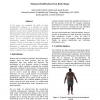Free Online Productivity Tools
i2Speak
i2Symbol
i2OCR
iTex2Img
iWeb2Print
iWeb2Shot
i2Type
iPdf2Split
iPdf2Merge
i2Bopomofo
i2Arabic
i2Style
i2Image
i2PDF
iLatex2Rtf
Sci2ools
3DIM
2003
IEEE
2003
IEEE
Human Identification from Body Shape
In this paper, we investigate the utility of static anthropometric distances as a biometric for human identification. The 3D landmark data from the CAESAR database is used to form a simple biometric consisting of distances between fixed rigidly connected body locations. This biometric is overt, and invariant to view and body posture. We use this to quantify the asymmetry of human bodies, and to characterize the interpersonal and intrapersonal distance distributions. The former is computed directly and the latter by adding zero-mean gaussian noise to the landmark points. This simulation framework is applicable to arbitrary shape based biometrics. We use gross body proportions information to model a computer vision recognition system.
| Added | 04 Jul 2010 |
| Updated | 04 Jul 2010 |
| Type | Conference |
| Year | 2003 |
| Where | 3DIM |
| Authors | Afzal Godil, Patrick Grother, Sandy Ressler |
Comments (0)

